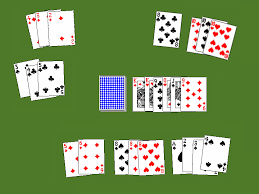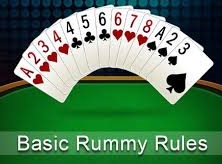Rummy Game Rules, is one of the most popular card games worldwide, cherished for its mix of strategy, skill, and chance. It is typically played with a standard deck of cards, and the objective is simple: form valid sets and sequences from the cards dealt. Whether you’re playing casually with friends or competing in an online tournament, understanding the rules of rummy is crucial to mastering the game. This guide outlines the fundamental rules, gameplay, and variations of rummy.
Objective of Rummy
In rummy, the primary goal is to arrange all the cards in your hand into valid sets and sequences. A set is a group of three or four cards of the same rank but different suits (e.g., 8♦, 8♠, 8♣), while a sequence is a consecutive group of three or more cards of the same suit (e.g., 3♣, 4♣, 5♣).
To win, a player must complete their hand with valid sets and sequences, ensuring that at least one of the sequences is a pure sequence (a sequence without using a joker). Once a player forms the required sets and sequences, they can declare the hand and win the round if their arrangement is valid.
Basic Rummy Game Rules
The standard rules of rummy are simple but form the foundation of the game. Here is a step-by-step breakdown of how a typical rummy game is played:
1. Number of Players
Rummy can be played by 2 to 6 players. For games with more than 6 players, two decks of cards are usually used.
2. Dealing the Cards
Each player is dealt a specific number of cards depending on the number of players and the version of rummy being played. In 13-card rummy, each player is dealt 13 cards, while in gin rummy, players are dealt 10 cards.
3. Jokers
Jokers (both printed and wild) are used in rummy to replace any card and help complete sets or sequences. The wild joker is chosen randomly after the cards are dealt, and it can be any card from the deck.
- Printed Joker: A printed joker in the deck can substitute any card to complete a set or sequence.
- Wild Joker: This is a randomly selected card that can act as a joker for the game. For example, if 4♠ is selected as the wild joker, all 4s (regardless of suit) become jokers.
4. Formation of the Stock and Discard Piles
After dealing, the remaining cards are placed face down to form the stock pile. The top card from the stock is placed face up to form the discard pile.
5. Gameplay
- On their turn, each player draws a card either from the stock pile or the discard pile.
- After drawing a card, the player must discard one card into the discard pile to maintain the hand size.
- The aim is to arrange the cards into valid sets and sequences. Players must keep at least one pure sequence and can use jokers to complete other sets or sequences.
6. Declaring the Hand
A player can declare the hand once all their cards are arranged into valid sets and sequences. They place their cards face up for the opponents to verify. If the declaration is valid (i.e., it contains at least one pure sequence), that player wins the round. If it’s invalid, the player incurs a penalty.
Scoring in Rummy
In rummy, points are calculated based on the unarranged cards (cards that are not part of any valid sets or sequences) left in the opponent’s hand after someone declares. The goal is to minimize points, as higher points mean a higher penalty.
- Face cards (K, Q, J, and Aces): 10 points each
- Number cards: Face value (e.g., 7 carries 7 points, 4 carries 4 points)
- Jokers: 0 points
The player who declares first scores 0 points, while the other players score based on the value of their unmatched cards. The player with the lowest points at the end of the game wins.
Important Terms in Rummy
- Pure Sequence: A sequence formed without the use of a joker (e.g., 5♦, 6♦, 7♦). Every player must form at least one pure sequence to declare.
- Impure Sequence: A sequence that includes one or more jokers (e.g., 5♥, Joker, 7♥).
- Set: A set is a group of 3 or 4 cards of the same rank but different suits (e.g., 10♠, 10♥, 10♦).
- First Life: The first pure sequence formed by a player is called the first life. This is mandatory for a valid declaration.
- Second Life: The second sequence (pure or impure) formed by a player is known as the second life. It is also necessary for a valid declaration.
Popular Variations of Rummy
Rummy has many variations, each with slight differences in rules and gameplay. Some of the most common ones include:
1. Points Rummy
- A fast-paced version where each game lasts for one deal.
- The winner earns cash or points based on the cards remaining in the opponent’s hand.
2. Deals Rummy
- Played for a fixed number of deals, the player with the lowest cumulative score at the end of all deals wins.
3. Pool Rummy
- Players try to avoid reaching a certain point limit, such as 101 or 201 points. Once a player exceeds the limit, they are eliminated.
4. Gin Rummy
- A two-player variant where players aim to form sets and sequences, and the game ends when one player knocks or forms all their cards into valid sets and sequences.
Key Tips for Winning at Rummy
- Prioritize the Pure Sequence: Always aim to form a pure sequence as early as possible, as it is mandatory for a valid declaration.
- Discard High-Value Cards: Get rid of high-value cards early in the game if they aren’t helping to form a sequence or set. This minimizes the points in your hand if your opponent declares.
- Use Jokers Wisely: Jokers can be incredibly useful for completing sets or sequences. However, focus on forming a pure sequence first before using jokers.
- Track Opponents’ Moves: Pay attention to the cards your opponents pick and discard, as this gives clues about their strategy.
- Balance Risk and Reward: Be strategic about holding cards. Sometimes it’s better to discard and create opportunities than to hold onto a risky hand.
Conclusion
Rummy is a game of skill, patience, and strategy. By understanding the basic rules and the importance of forming valid sets and sequences, you can enhance your gameplay and increase your chances of winning. Whether you’re a casual player or a serious competitor, rummy offers endless entertainment and challenge. So, grab a deck of cards or join an online platform and start playing.





